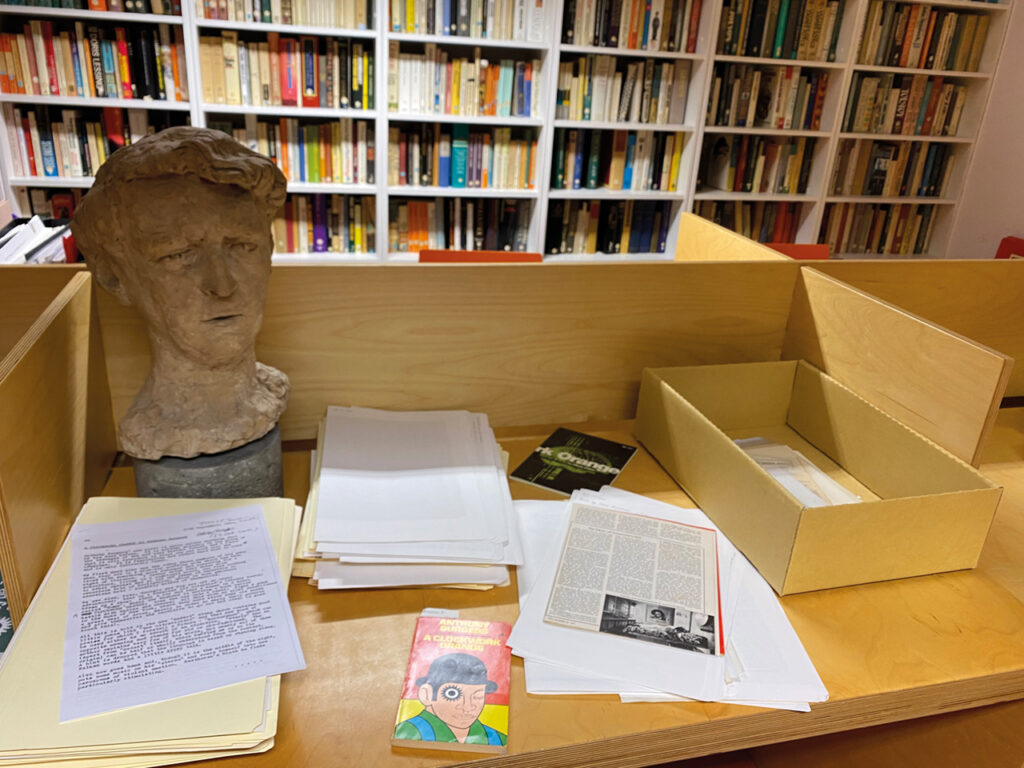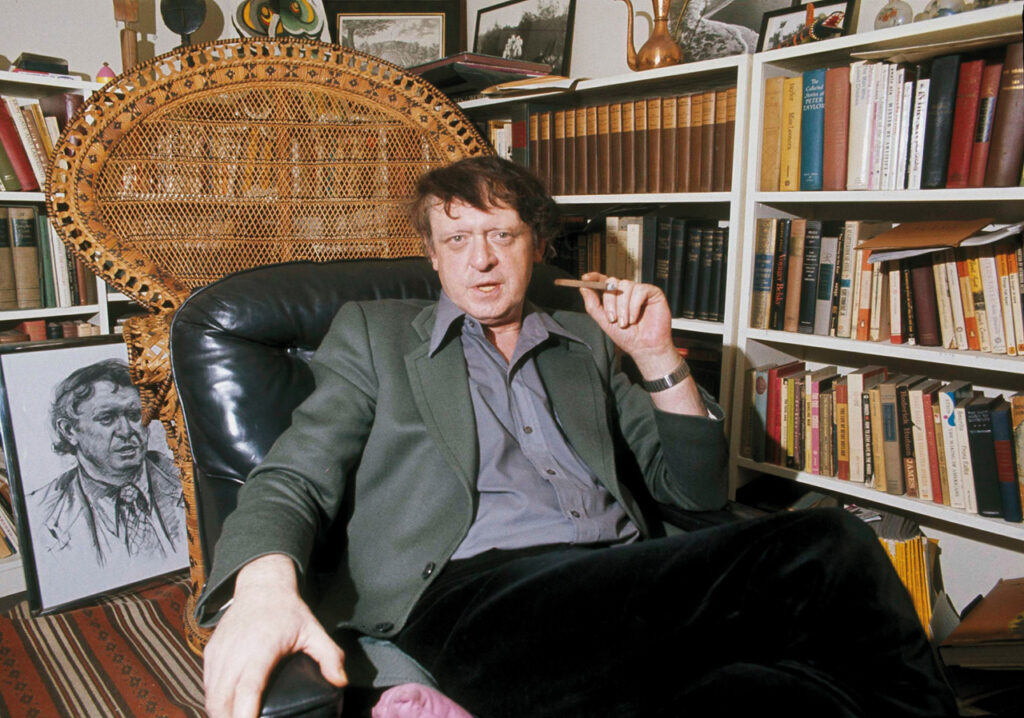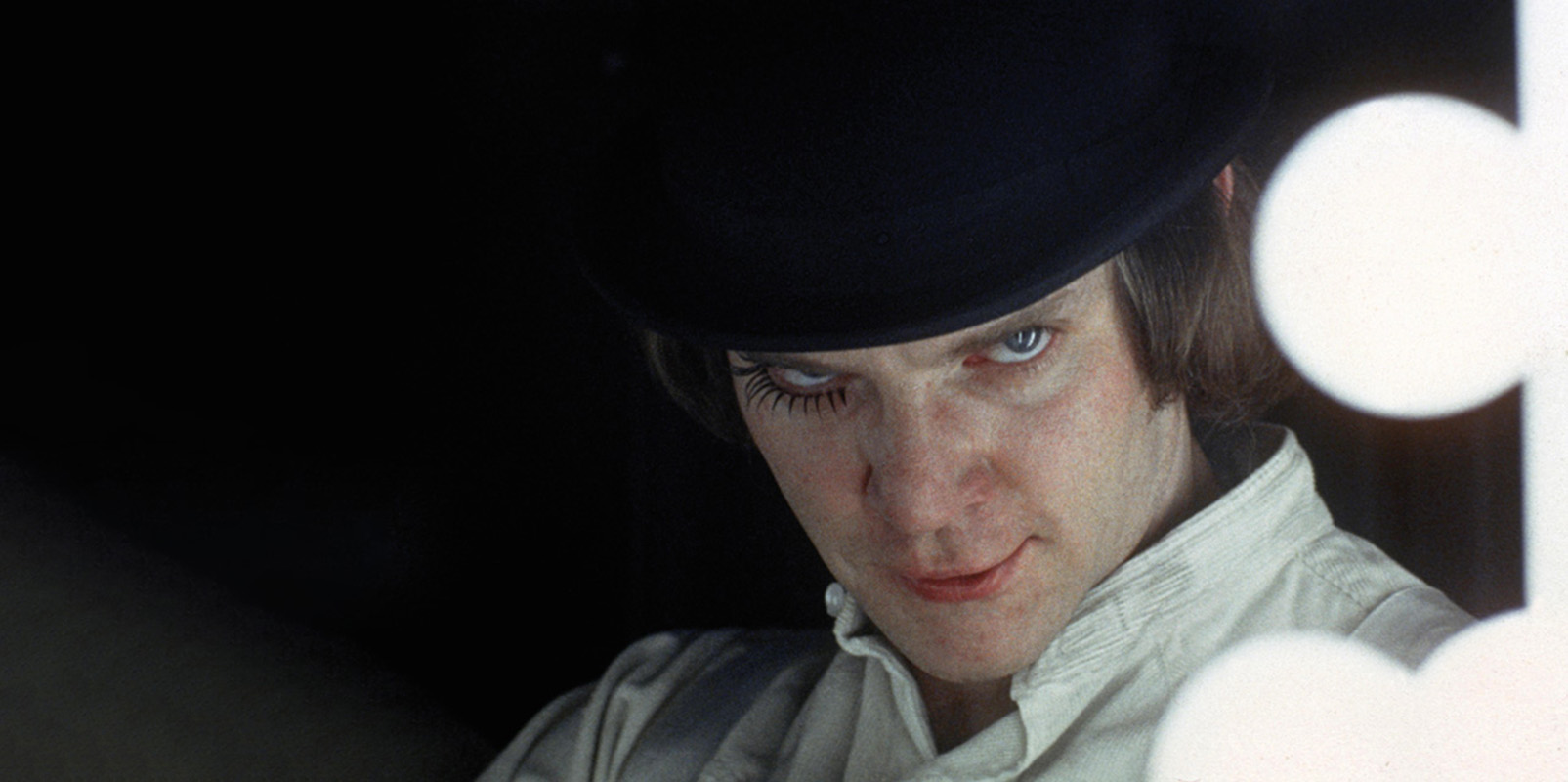A sweet and sour wind up
Anthony Burgess’s A Clockwork Orange and Stanley Kubrick’s notorious film adaptation celebrate notable anniversaries in 2022, but why did the author sour on his best-known work?
What’s the first thing you think of when you see the words A Clockwork Orange? It’s probably something from Stanley Kubrick’s controversial movie, adapted from the novel by Anthony Burgess. Malcolm McDowell in bowler hat and jockstrap as Alex, striding along with his fellow “droogs”, prowling the streets of a dystopian Britain for some of the old ultraviolence. And, if you’ve seen the film, you probably hear McDowell’s inimitable voice too, his broad northern vowels to the fore as they curl around the story’s peculiar slang. Viddy well, and all that.
That northern connection was no coincidence of casting. Among the many gems in the archives of the International Anthony Burgess Foundation, a small but densely packed building in Manchester, are recordings of Burgess himself reading from his most notorious work. And he does so in a broad Lancashire accent. That’s because while he travelled the world and lived everywhere from Malaya to Monaco, Burgess was a Mancunian first and foremost.
Born in Harpurhey in 1917, his family later lived above the Golden Eagle pub on Lodge Street in Miles Platting, and then moved to Moss Side. While his travels and education gave him the crisp accent of the Englishman abroad, the many extant recordings – especially those in which he talks about his family and childhood – show that his Lancastrian dialect would easily slip back in.
That doesn’t mean that the amoral thuggery of A Clockwork Orange was drawn from the streets of Manchester though. The book, published 60 years ago in 1962, marked a sharp deviation from the colonial comedies he was known for in the 1950s, and that’s because of the dark and unusual circumstances under which it was written.
Burgess was working as a teacher in Malaya when he was suddenly taken ill. Doctors solemnly informed him that he had an inoperable brain tumour and probably had less than a year to live. Returning to England with his wife, Lynne, Burgess began hammering out work at an astonishing pace, trying to build up enough money to support her through her impending widowhood.
“With luck the book will be a big success and give the teenagers a new language. But it might be an enormous flop.”
A Clockwork Orange came out of this desperate period, written in just six weeks. It tells the story of Alex, a teenage hooligan – or “droog” in the book’s slang dialect known as “Nadsat” – who fills his days drinking milk-plus laced with drugs, before heading out with his friends to commit acts of what he calls “the old ultraviolence”. When Alex is captured by the police, he is forcibly conditioned by the state using brainwashing techniques until he is nauseated by the idea of violence. Newly vulnerable, he falls prey to some of his own victims and even his own former friends. In the final chapter, his programming broken, he decides to let go of his old ways of his own free will and become a productive member of society – a moral absolution that Burgess, a lifelong Catholic, was particularly keen to promote.
The brutal droog gangs were partly inspired by the culture shock Burgess felt returning to his homeland, finding a post-war landscape of Teddy Boys and other extravagantly dressed youth cults. He drew even more personal inspiration from an incident in 1944, when Lynne was attacked by US servicemen during a blackout, causing her to miscarry. The harrowing scene in which Alex and his droogs invade the home of a novelist and his wife was based on this savagery.
In a real-life plot twist that would beggar belief in fiction, Burgess had been misdiagnosed. He was not dying after all, and nobody was quite sure what to do with A Clockwork Orange, given that it was so ferociously different to Burgess’s other work. “Fascinating but rather hard work to read” was the initial verdict from an impressed if slightly stunned proof reader at William Heinemann, Burgess’s publisher. “With luck the book will be a big success and give the teenagers a new language,” they concluded. “But it might be an enormous flop. Certainly nothing in between.”
That appraisal document is one of many in the archives of the International Anthony Burgess Foundation on Cambridge Street. Downstairs from the café and performance space, through a public display of the author’s many typewriters, is the reading room and the archive. These rooms are also open to the public, by appointment, and contain an astonishing array of material from throughout the author’s life, including many of his personal effects – shelf upon shelf of ornaments and appliances from his home. There’s something especially intimate about seeing the mundane belongings of such an influential figure all gathered together – a combination VHS player portable TV, a harmonica, a variety of ashtrays.
Then there are the books. Bookcases line the walls, including his own personal library – hundreds of non-fiction titles on every conceivable subject, as well as favourite recipe books and hand-annotated dictionaries. There are sections for books that discuss Burgess and his work, books that contain essays or reviews by Burgess, and of course, an entire wall devoted to the many different editions of everything he wrote.
It’s here that it becomes clear how difficult A Clockwork Orange was to market. There’s a Japanese edition with a cover that evokes the psychedelic cartoon style of The Beatles’ Yellow Submarine. There’s a US edition with a motorbike-themed cover clearly intended to ride on the popularity of Easy Rider. Most famously, there’s the 1972 Penguin edition with David Pelham’s minimalist design – a faceless droog, his single eye wearing mascara in the shape of a mechanical cogwheel. Burgess’s own copy of this edition, rather wonderfully, has been vandalised by the author himself, a pouting mouth and other features scribbled on with biro.
This defaced copy illustrates the complicated relationship Burgess had with his most famous work. Between the frantic method of its creation and its modest sales success when originally released, it’s fair to assume that Burgess never expected to think or talk about A Clockwork Orange very much ever again. Except, as the 1960s counter-culture movement gathered momentum, the novel’s rebellious themes meant its cult appeal kept growing.
Andy Warhol’s 1965 film Vinyl was a bootleg adaptation of Burgess’s story, while Mick Jagger was among the book’s vocal supporters. Indeed, at one point, Ken Russell was set to direct an official film version with Jagger as Alex and the rest of the Rolling Stones as his droogs. Eventually, however, the rights reached Stanley Kubrick, then looking for a project to follow 2001: A Space Odyssey.

Burgess was not against the idea of a film adaptation, despite having sold the movie rights for a pittance. Although he had no creative input into the production, he and Kubrick initially hit it off, both being well-read men who enjoyed debating culture and politics. At one point, Burgess was lined up to write the screenplay for Kubrick’s passion project – a biopic of Napoleon.
The film, of course, became an instant sensation when it was released in London in early 1972. One of a notable wave of shockingly violent movies such as Bonnie & Clyde and The Wild Bunch, it was inevitable given the British setting and confrontational themes that the usual UK tabloids would seize on it for a moral crusade. Much of the material in the A Clockwork Orange boxes in the Burgess Foundation’s archive date from this tumultuous period, with clippings and transcripts of feverish newspaper coverage from around the world – but particularly the UK. Kubrick was famously so taken aback by the response in Britain, and so shaken by death threats he received, that he withdrew the film from circulation here. It would not be legally available until after his death in 1999.
With Kubrick pulling up the drawbridge, this left Burgess to face the slings and arrows of the press by himself. To begin with, he defended both his story and Kubrick’s adaptation wholeheartedly, praising the film’s “classic quality” and “remarkable integrity”. Among his papers is the typed manuscript of a lengthy rebuttal Burgess wrote for the Los Angeles Times in which he refers to “my and Kubrick’s parable”. In interviews, Burgess railed against the “bloody judges” who fed the moral panic by connecting acts of youth violence to the film.
By August 1973, however, it seems Burgess was growing tired of having to constantly defend someone else’s adaptation of his work. The reasons for his disillusionment are many and complicated, but at their core was the fact that Kubrick was working from the US edition of the novel, which had the redemptive final chapter removed against Burgess’s wishes. It certainly didn’t help that the same US publisher who crudely truncated his work then put out an illustrated version using stills from the movie and sold it as Stanley Kubrick’s Clockwork Orange.
“The worst thing about the controversy is that I have become known for one book,” Burgess complained, perhaps understandably given that the story was one he dashed off in less than two months to pay the bills. “I would not mind if I liked the book. But I regard it as being too light and too gimmicky.” By 1975, Burgess was politely mocking Kubrick in the press. “Kubrick is a very competent interpreter of other men’s ideas,” Burgess told the Dallas News. “But he is not a great filmmaker like Fellini.”
In 1987, Burgess wrote a musical theatre version of A Clockwork Orange, to put a stop to the many unlicensed amateur adaptations being staged. The play ends with a man, “bearded like Stanley Kubrick”, who invades the stage playing Singin’ In The Rain on a trumpet, only for the cast to kick him off.
Kubrick, for his part, never publicly responded to Burgess’s provocations and over time it seems Burgess made a perhaps uneasy peace with his most famous work and its long cultural shadow. In later years, interviewers would be asked by Burgess’s publicist not to mention A Clockwork Orange, only for the author to bring it up himself, unbidden. It’s notable that as rich and detailed as it is, the A Clockwork Orange material accounts for only a few boxes out of dozens in the Burgess archive. He wrote dozens more books – including the Booker-nominated Earthly Powers – and composed music and poetry until his death from lung cancer in 1993, aged 76. His final book, Byrne, published posthumously, was a passion project, a novel written entirely in Byronic verse.
The fact that Burgess wrestled with his creation and its impact seems very appropriate today – its themes remain painfully relevant as society goes through yet another of its regular cultural contortions.
“I don’t know how much free will man really possesses,” Burgess wrote in his defence of both book and film in 1972. “But I do know what little he seems to have is too precious to encroach on.”

Anthony Burgess returned to England in 1959 after being misdiagnosed with a fatal brain tumour. Believing he had less than a year to live he began to write at incredible pace, producing a series of “terminal novels”, including his most famous work: A Clockwork Orange.
The book drew its title from a slang phrase Burgess had heard in London: “as queer as a clockwork orange”. Meant to communicate something’s wrongness, Burgess wanted to imply an extra dimension: a clash of the sweet and organic against the cold and mechanical.
On release in 1962 the book sold poorly but was reviewed well, with critics simultaneously appalled by its violence and grabbed by its ideas.
Ten years later Stanley Kubrick’s film adaption was a financial success, but the violence it depicted drew the attention of the British tabloids. Headlines began to claim that violent crimes and gangs had been inspired by A Clockwork Orange, and after Kubrick’s family received death threats he withdrew the film.
In a 1989 BBC interview, Burgess wondered whether his false diagnosis was a ruse to drum him out of the colonial service because he had written articles in support of Brunei’s revolutionary opposition party and his wife had made an obscene comment to the Duke of Edinburgh.
Burgess continued to produce other literature and music, once saying: “I wish people would think of me as a musician who writes novels, instead of a novelist who writes music on the side.”
Constantly referenced and invoked, the themes and language of A Clockwise Orange are now shorthand for a culture of extreme violence and an argument over whether its adherents can be redeemed.

Leave a reply
Your email address will not be published.